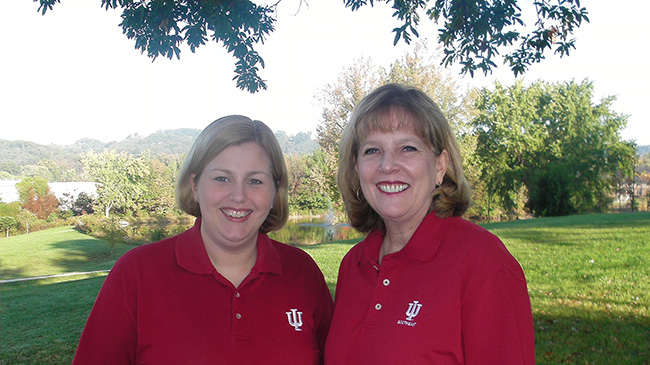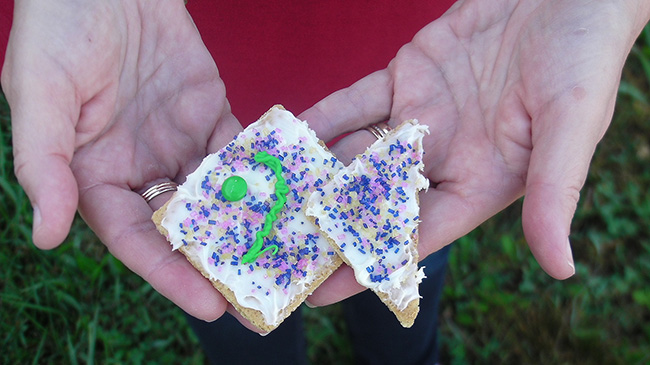To spend time with education professors Dr. Deborah Mink and Dr. Jacque Singleton is to experience the joy of elementary education — and cookies.
Both joy and cookies were on display when the two IU Southeast faculty members presented “The Rainbow Fish Loves Math” at last month’s Indiana State Reading Conference in Indianapolis, Ind. Now in its 50th year, the conference brings together educators from across the state to share innovative methods for advancing the practice of literacy teaching and sowing the seeds of lifelong learning.
Mink and Singleton presented their take on Swiss author Marcus Pfister’s worldwide best-selling children’s book, The Rainbow Fish. As parents know and appreciate, the book is a simple but effective parable about sharing. But in the hands of the IU Southeast faculty — and, eventually, their students — it becomes a Swiss Army knife of learning exercises that are tailored to fulfill Indiana state standards in reading, math and science for both elementary school students and their teachers.

Dr. Jacque Singleton and Dr. Deborah Mink discover cross-disciplinary possibilities in The Rainbow Fish.
The current Indiana standard for student achievement is the Indiana Statewide Testing for Educational Progress (ISTEP) exam. It assesses the progress of elementary and middle-school students in fundamental areas of English language arts and mathematics. Elementary education graduates will be administering these tests, and a large part of their working lives will be spent helping their students prepare for them.
But before they can do this, teaching students have to run a gauntlet of their own: the Indiana CORE Assessments for Educator Licensure, a series of demanding exams through which students demonstrate they are qualified to teach in Indiana public schools.
“The Rainbow Fish Loves Math” seeks to meet and surpass the bar set by these tests. And to make it enjoyable.
“The new tests for both students and educators are very challenging,” said Mink, who has been working with the book for nearly a decade. “That’s why I came up with something that was both instructional and fun, to help the students remember the skills they are learning.” While necessary to keep children engaged, the playfulness is deceptive. These exercises incorporate an innovative integrated approach based on a foundation of advanced teaching scholarship and years of classroom experience.
For math, the faculty use The Rainbow Fish to teach data analysis and required concepts like mean, median and mode. Statistics and raw numbers also come into play, via trivia games involving facts about the book, including publication data, global readership and even the author’s age and how much money the book has grossed. Concepts of algebra are introduced through activities involving patterns and sequences using the the visual language of The Rainbow Fish.
Literacy is not just a matter of comprehending words, but of carrying out more complex tasks of information processing via language. Here pattern blocks are used to create designs that the students then recreate in teams, one describing and the other trying to follow the description, an exercise in speaking, active listening, and the acquisition and use of vocabulary. This transformational activity is an important ISTEP milestone.
For science, the students are asked to consider the protagonist of The Rainbow Fish as a real type of fish, complete with gills, fins, scales and other body parts. From here, the exercise expands again into fish stats and info from around the world, introducing different species of fish, different human cultures, even historical knowledge about fishing.
Mining aspects of the book for cross-disciplinary information, Mink and Singleton have found a way to create new pathways to nearly infinite teaching and learning possibilities.
The faculty won praise from conference attendees — nearly all teachers — for integrating the different disciplines, a key factor in the everyday reality of the classroom. Both educators come from a teaching background, and that experience in the trenches helps them anticipate and prepare their students for the real-life demands of the teaching environment.
Speaking to the need to provide innovative approaches, Singleton said, “If you don’t seek constant improvement, your ideas will become stagnant and fail to meet the needs of your students.”

The Rainbow Fish cookie, an edible exercise in geometry.
And the cookie? It fulfills another important test requirement. Not the cookie itself, but the concepts illustrated in baked, sprinkled and edible form. ISTEP asks students to use two-dimensional shapes to create a composite shape, and compose new shapes from the composite shape. Enter the cookie: a square and a triangle, fused to make a new shape.
“It’s our piece de resistance,” said Mink. “Students take a picture of a real fish, create a Venn diagram for purposes of comparison, and then use these to create the cookie. And then they eat it.”


